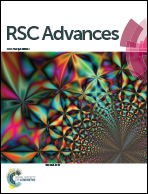Combined photophysical, NMR and theoretical (DFT) study on the interaction of a multi component system in the absence and presence of different biologically and environmentally important ions†
Abstract
A simple multi-component system, comprising fluorophore (dansylamide), spacer (propyl) and receptor (dimethylamino) units, has been synthesized in order to investigate the receptor–analyte binding interactions in the presence of both cations and anions within a single molecular system. While the acidic N–H proton of the dansylamide group is expected to interact with a basic anion, the dimethylamino group is expected to interact with metal ions. The photophysical behaviour of this system in the absence and presence of various metal ions and anions is investigated in acetonitrile (ACN) medium. The absorption and fluorescence spectra of the system in ACN consist of broad bands, typical of the intramolecular charge transfer (ICT) nature of the system. A significant reduction in the fluorescence intensity of the system in the presence of fluoride has been observed. No significant changes in the optical properties of the system have been noticed in the presence of other commonly encountered anions. The interaction of fluoride with the present system has also been monitored through 1H NMR experiments. The formation of the HF2− species due to the abstraction of the acidic proton by F− is believed to be responsible for the fluoride ion selective signalling behaviour. In the case of cations, a bathochromic shift in fluorescence, as well as a concomitant decrease in fluorescence intensity, of the present system has been observed in the presence of transition metal ions. Interestingly, no bathochromic shifts in absorbance or fluorescence, were observed when a similar experiment was carried out employing a structurally similar compound which is devoid of the dimethylamino group. The cation signalling event has also been monitored through FTIR and 1H NMR experiments. Spectroscopic results indicate a ground state 1 : 2 complex formation between the present system and the transition metal ions. Theoretical calculations have also been carried out in the presence of various analytes to throw more light on the binding interactions. Additionally, through fluorescence microscopy studies, it has been observed that the present system is non-toxic in a cellular environment, and has the potential to be used in live-cell imaging studies.


 Please wait while we load your content...
Please wait while we load your content...